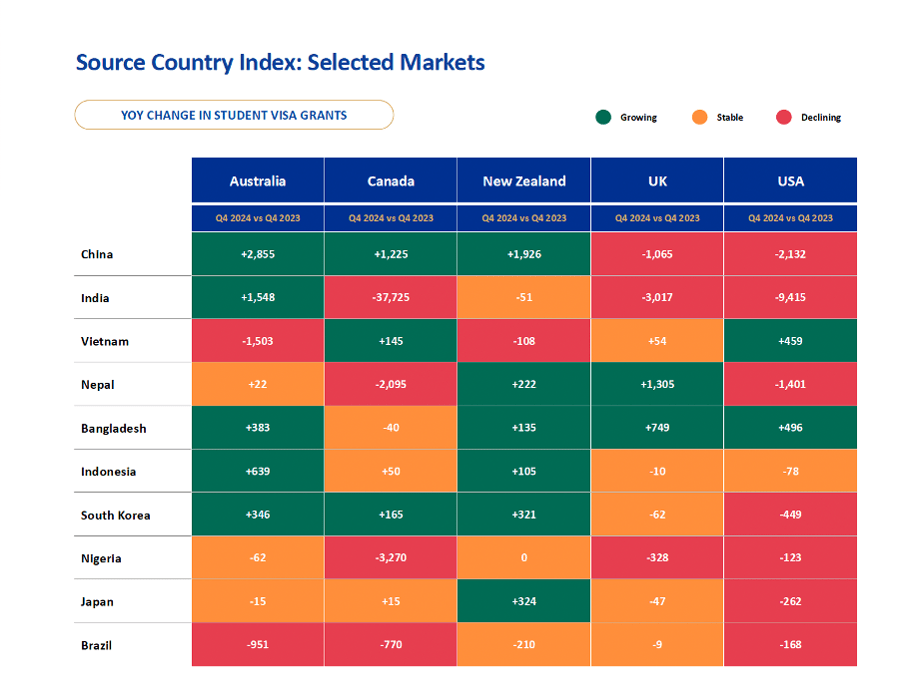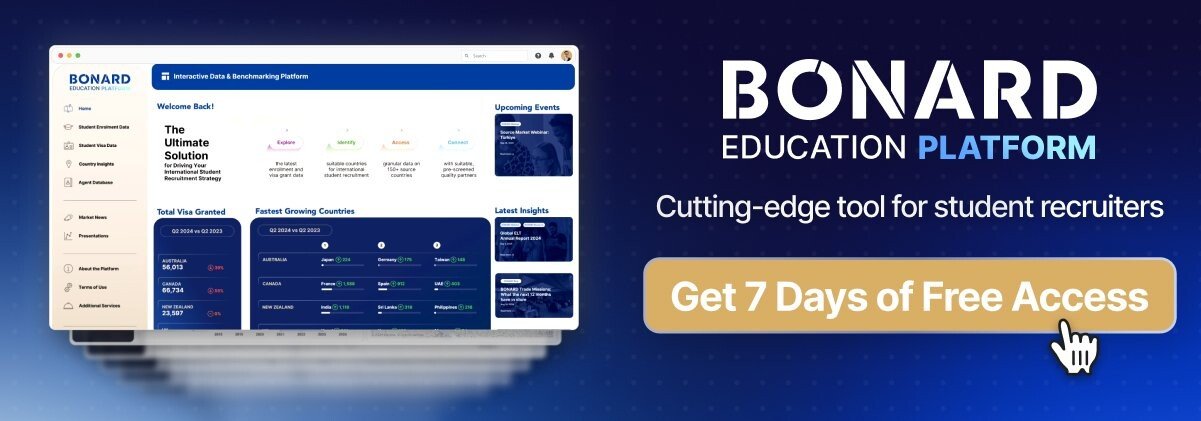
ZOOM WEBINAR
2024 was a rollercoaster for international education. What will 2025 look like?
Market trends, analysis, and recruitment advice based on the latest visa data
2024 was a rollercoaster for the global international education sector. What will 2025 look like? Here is what the latest Global Student Flows Briefing reveals
Market trends, insights and recruitment advice based on the most recent visa statistics
Let’s start with the positive news: after a tumultuous year, student visa issuance statistics showed some stabilisation in the last quarter of 2024, even in destinations where the sector was rocked by policy changes, such as Australia and Canada.
And student flows from China, the most important source country globally, finally started growing again, although not in all study destinations.
However, the picture is not completely rosy. Growth in most source markets remains mild as demand for traditional study destinations wanes in favour of alternative destinations offering more affordable programmes and friendlier visa policies. Ongoing uncertainty caused by visa processing delays and refusals in several destinations will likely create further challenges in 2025.
In the latest Global Student Flows Briefing, the BONARD Education team presented an in-depth analysis of the most recent student visa data across five key destinations - Australia, Canada, New Zealand, the UK, and the US - tracking the performance of several source markets worldwide.
This data provides valuable insights into the state of the international education sector and supports evidence-based planning and forecasting.
Visa issuance data reflects changing student preferences almost in real time, while visa grant rates indicate how those preferences may change in the future.
All data shared during the webinar was drawn from the BONARD Education Platform, an innovative tool that enables institutions to access and use visa and enrolment statistics covering five study destinations and over 200 source markets.
How destinations performed in 2024, and what we can expect from 2025
“Institutions don’t fully take advantage of visa statistics to inform marketing and strategic planning,” said Patrik Pavlacic, BONARD’s Chief Intelligence Officer.
“Through the Global Student Flows Briefings, we want to provide educators with the most recent analysis of student flows by looking at visa issuances and grant rates.”
While visa issuances give a real-time picture of demand levels, grant rates are especially important to monitor, as low or unstable grant rates can jeopardise student recruitment from specific source countries.
“In Australia and Canada, grant rates have been on a rollercoaster,” Pavlacic explained.
“This has contributed to uncertainty among students, agents, and parents, to the point that it has affected recruitment from several markets.”
In New Zealand and the UK, grant rates remained largely stable in 2024, but ongoing visa processing challenges in other destinations dampened demand.
Key takeaways by destination
Australia
After a strong post-pandemic rebound, changes in government policy took their toll. In 2024, student visa grants dropped by 24% compared to 2023. The latest statistics show the situation improved in the last quarter of 2024, but this was mainly driven by growth in the higher education sector, while the ELICOS and VET sectors continue to struggle.
“The Q4 stabilisation could continue in Q1 and Q2 2025,” Pavlacicexplained. “This would be a very important positive signal for prospective students and their families, and for agents.”
Canada
The impact of restrictive immigration policies on the international education sector is evident in Canada. Between 2023 and 2024, the number of new study permits issued plummeted by 32%, and a further 15% decline is expected in 2025.
Sarah Verkinova, BONARD’s Head of International Education, commented: “I think it’s important to understand that these trends highlight the profound impact of policy changes on student mobility to Canada, and raise important questions about the future of the country as a top international education destination.”
New Zealand
New Zealand was the best-performing study destination in 2024. While New Zealand was the last study destination to recover post-pandemic, its performance remained consistently positive after its border reopened in 2022. Visa issuances grew by 26% in Q4 2024, and the outlook for 2025 is positive, with demand for study programmes in the country expected to keep growing this year.
United States
In the US, 2024 started on a positive note but progressed into uncertainty, which translated into a 21% drop in F-1 visas in Q3 and a further 16% in Q4. Visa processing delays and refusals continued to create major challenges in the sector, and ongoing uncertainty is likely to further impact institutions in 2025.
“Visa delays and refusals can deter students from applying to a specific programme and can also shift student preferences towards alternative destinations,” Pavlacic explained.
United Kingdom
After five quarters of decline, the situation in the UK stabilised in Q4 2024. Judging by monthly visa statistics, the picture is relatively positive, with the country achieving the highest visa grant rates among all other destinations thanks to its student sponsorship model. The recruitment environment in the UK is certainly more favourable at the moment than in other countries.
“Whether the UK will benefit from changes in competing destinations, especially the US, remains to be determined,” added Dave Amor, Associate Researcher at BONARD.
Where are students going?
China’s back – that’s certainly the most positive and most awaited finding of the briefing. After a sluggish recovery post-pandemic, international student mobility from China finally started to grow, but not in all destinations. The country was the leading force behind growing student numbers in Australia, Canada and New Zealand, but the UK and especially the US saw demand decline.
Beyond China, the visa statistics also showed several other noteworthy trends, revealing how changing preferences shape international student flows. Here is a selection:
India – The second-fastest growing market for Australia and stable in New Zealand. Visa numbers declined in the UK and US, and dropped significantly in Canada.
Pakistan, Nepal, and Bangladesh – Strong performers, particularly in the UK and US, helping offset India's slowdown.
Vietnam – Mixed results: significant declines in Australia, moderate growth in the US.
Sri Lanka – High visa approval rates, especially in New Zealand, where it is considered a promising market.
Myanmar – Increasing interest in New Zealand, the UK, and the US, while interest in Canada and Australia is falling.
Indonesia – Growing in Australia, New Zealand, and the UK; fewer students choosing the US.
Latin America – Despite its importance as a region, most markets are in decline, primarily due to visa complications.
The situation is definitely more positive than in Q3 2024 when, apart from New Zealand, most cells in the table above were red.
However, only a handful of markets are growing significantly for the five destinations included in the briefing.
“This urges us to look at the bigger picture and ask: where are students going?” Pavlacic explained.
“Recruitment is slow for the ‘big four’ [Australia, Canada, UK, US], and we know that other destinations offering more affordable programmes and friendlier visa policies are growing in popularity.”
These destinations include countries like Germany, France, Italy and Spain in Europe, Asian destinations such as Malaysia, China and South Korea, and other education hubs such as Dubai.

Recruitment Insights
“It’s essential for institutions to be on the front foot when it comes to student recruitment because, at the moment, the market doesn’t offer the same organic growth opportunities as it used to, at least for traditional study destinations,” Pavlacic explains.
Drawing from the statistics and soft intelligence at BONARD’s disposal, the team made several recommendations for institutions recruiting international students.
BONARD’s recommendations include:
Invest in visa preparation support
For educators in every destination country, even those with relatively high visa grant rates, it is essential to invest time and resources into preparing students for the visa application process.“In Canada, for example, there have been success stories where institutions supported students to prepare the right documents for their student visa application, especially proof of funds,” Pavlacic explained.
Highlight support in communications
This reassurance is key in marketing, and when speaking with agents, students, and families.“I think it’s very important to communicate this type of support in your marketing messaging and in conversations with agents and prospective students.”
Communicate clearly and transparently
Clear communication strategies to build trust with agents, students and families are fundamental, especially for destinations where policy changes or low visa grant rates have created a sense of ongoing uncertainty.Diversify source markets
Diversification of source markets also remains an imperative in the current climate. A broader recruitment strategy can reduce risk and create new opportunities.
Most importantly, visa statistics should be considered as an essential tool that allows institutions to always be proactive and prepared.
Visa data as a strategic tool
BONARD strongly recommends using visa data to forecast, plan, and optimise recruitment.
“By analysing visa issuances and visa grant rates, institutions are able to predict future student intakes and compare source market performance across multiple destinations,” said Pavlacic.
“This enables them to target marketing campaigns to markets delivering growth, and also to identify emerging markets for international student recruitment.”
The Global Student Flows Briefings present a snapshot of data from the BONARD Education Platform, which offers in-depth visa and enrolment analytics for five destinations and over 200 source markets.
WEBINAR RECORDING
Missed the live session? The full recording is available for subscribers or upon request (via the form below), or get in touch with us at education@bonard.com
CONTACT FORM
Recording and presentation - request form
Access the latest international student mobility trends by submitting this form
Do you want to learn more about the presented data? Explore our data platform - the most advanced source for international education market intelligence.


